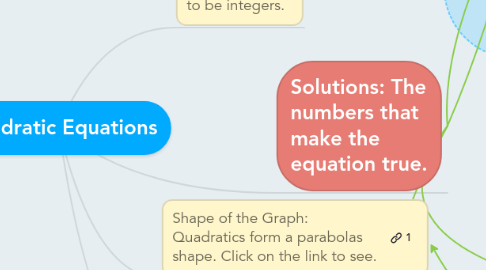
1. Factoring
1.1. Works best with
1.1.1. small numbers (especially when a is small)
1.1.2. Not all quadratics can be factored
1.2. Steps:
1.2.1. 1. Find factors of c that add to give you b
1.2.2. 2. Write two binomials with those factors so that that FOIL to give you the original.
1.2.3. 3. Set each binomial equal to 0 and solve.
2. Produces one or two real...
3. Completing the Square
3.1. Works best when
3.1.1. b is an even number so you can divide by 2
3.1.2. ALWAYS WORKS
3.2. Steps:
3.2.1. 1. Move c to the other side.
3.2.2. 2. Divide b/2 and square that number.
3.2.3. 3. Add the number you just got to both sides.
3.2.4. 4. Combine like terms on each side and then factor the trinomial.
3.2.5. 5. Take the square root of both sides and solve.
4. Standard Form: ax^2+bx+c=0 a,b, and c have to be integers.
5. Solutions: The numbers that make the equation true.
6. Produces one or two real or nonreal...
7. Imaginary (nonreal) roots
7.1. When a negative is under a radical, take it away by multiplying by "i" out front. Treat i like a variable. P.S. i^2=-1
8. Shape of the Graph: Quadratics form a parabolas shape. Click on the link to see.
9. Solutions
9.1. You can check to see if you're right by plugging these numbers into the original equation.
10. Quadratic formula
10.1. Works best when
10.1.1. You cannot factor
10.1.2. b is an odd number
10.1.3. you have bigger numbers
10.1.4. ALWAYS WORKS
10.2. Steps:
10.2.1. 1. Ensure quadratic is in standard form.
10.2.2. 2. Plug into the equation: (-b+sqrt(b^2-4ac))/2a
10.2.3. 3. Simplify
10.2.4. 4. Split the positive and negative square root to determine your solutions.
11. Definition: A quadratic equation is an equation that has one variable squared
12. Produces one or two real or nonreal...
13. Produces one or two real, possibly rational,...
14. Graphing
14.1. Works best when
14.1.1. You're allowed to use a graphing calculator
14.1.2. You have really large or complicated numbers
14.1.3. Only works when there are real solutions
14.1.3.1. Look at the second and third graphs in the link.
14.2. Steps
14.2.1. 1. Plug the equation into Y1.
14.2.2. 2. Hit "2nd+calc" and then select zeros.
14.2.3. 3. Choose your left bound above first root.
14.2.4. 4. Repeat process with right bound below root.
14.2.5. 5. Repeat process again with second root if it exists.
